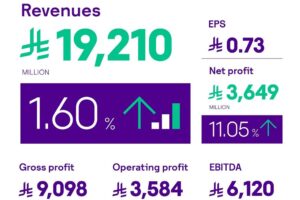By: Gulraiz Khalid
The quality of internet services in Kuwait has significantly improved over the past two years, thanks to 4G and 5G networks. Before 2020, Kuwait’s 4G experience trailed leading 4G telecom markets such as Korea & Singapore, with an average download speed of 40 to 50 Mbps. A massive shift has since occurred, with the 4G user experience speed increasing 2.76 times from 6 Mbps in 2015 to 16.2 Mbps in 2019, based on independent OpenSignal reports.
Mobile broadband dominates internet access in Kuwait due to low fiber penetration; CITRA’s latest figures show that 84.8% of Kuwaiti families access the internet through their mobile devices. Mobile broadband penetration now exceeds 100% in Kuwait. Operators have invested significantly in infrastructure to sustain this growth. Large-scale 3G to 4G user migration quickly drove 4G to the maturity stage and spearheaded a true smartphone revolution. Multimedia sharing, social media, e-commerce and online gaming powered by 4G laid the foundation for the eventual 5G roll-out.
The Kuwaiti telecom market has traditionally been very competitive. An HSDPA 7.2 Mbps service was available as early as 2007, followed by the region’s first nationwide 4G network in 2013. Meanwhile, Kuwait launched the region’s first commercial 5G service in 2019. Operators have since rolled out the region’s first commercial deployment of advanced 5G technologies to enable better 5G indoor customer reach and additional 5G capacity to cater to the unexpected 30% surge in traffic during the pandemic. Ookla highlighted in their recent report that Kuwait has the region’s highest 5G network availability at 35%. Kuwait ranks within a list of top six countries with the fastest 5G worldwide, while “Kuwait City” ranks as the fastest city in the world. In addition to 5G quality of service development, Opensignal shows that 4G internet speed reached around 40 Mbps average download speeds and 94.4% 4G availability, respectively, in February 2022. Kuwait networks are, therefore, one of the leading mobile broadbands worldwide, based on global user experience platforms.
Mobile operators’ continuous 4G and 5G network improvement measures have provided noticeable capacity improvement in Kuwait’s 4G and 5G Mobile infrastructure. CITRA’s latest QoS Audit network report shows that 4G/5G Internet services from the three operators improved significantly in 2021.
It is worth noting that 5G capability goes beyond traditional 4G connectivity; it is the next step in the evolution of mobile technology that can enable different vertical industry use cases in the business-to-consumer, business-to-home and business-to-business domains. Data shows that 5G subscribers in Kuwait have already reached 1.2 million subscribers and are expected to grow exponentially in the foreseeable future to get above 50% penetration rate. Nationwide 5G coverage, fast internet speed, a wide range of affordable 5G devices, competitive 5G offerings and reasonable pre-paid and post-paid packages are key drivers for customers to switch their subscription plans to 5G.
In the enterprise space, services such as 5G Dedicated Access (DA) connectivity, IT solutions, IoT, security solutions and cloud have proved popular. Advanced services such as drones, 5G live Bus and virtual reality for healthcare, financial, education, hospitality, Oil & Gas, retail, and government sectors have attracted new future-oriented customers.
However, enterprise 5G services, in particular, demand strict attention to detail to prevent O&M failures. This has led to an increased demand for advanced 5G features such as large uplink bandwidth, low latency, multi-connection, and 5G network slicing, now widely required in many mission-critical scenarios. For example, an aggregated uplink broadband connection of only three remote industrial HD video surveillance cameras will need 75-120 Mbps to stream concurrent video channels. The significant uplink bandwidth demand would encounter an uplink capacity issue under the 5G base station, resulting in an operator’s inability to commit to SLAs required by an enterprise.
Continued development of 5G requires allocating more than one spectrum block to operators to maximize 5G’s potential and improve the user experience. Having multiple licensed 5G spectrum blocks will improve experience capabilities as follows:
- In hotspot areas where many people are using 5G services simultaneously
- In radio cell edges where subscriber locations are far away from 5G radio sites
- An overall experience improvement in sites that utilize more than two large 5G spectrum blocks
- Enabling operators to have much more flexibility in provisioning their networks and to deploy the latest 5G technologies, such as 5G carrier aggregation (CA) – 5G carrier aggregation is an essential tool that can significantly impact 5G mobile performance for the end-user by concatenation of multiple 5G carriers. It can improve network capacity and enable 5G carriers to deliver increased speeds, lower latency, more comprehensive coverage, and enhanced user experience. 5G CA features are already available in commercial 5G phones and routers, such as the latest models of iPhone, Samsung Galaxy series and Huawei CPEs. 5G subscribers can enjoy its experience as soon as the 5G networks offer it
In the region, Saudi and UAE regulators have already awarded local mobile operators the second 5G spectrum band. In 2020, Saudi became the region’s first country to successfully commercialize 5G carrier aggregation services. The Communications Regulatory Authority of Qatar has recently allowed implementation on the second C-band spectrum for mobile operators. Meanwhile, the Communications and Information Technology Commission of Saudi Arabia has awarded multiple 5G spectrum bands this year.
Sustaining and improving quality of service (QoS) are critical factors in supporting subscription growth and boosting 5G’s contribution to digitalization goals in the public and the private sectors. Continuous development of the 5G network experience will maintain Kuwait’s leadership position in 5G and support the telecom industry’s contribution to Kuwait’s digital transformation plans in line with Vision 2035.












